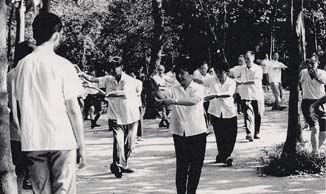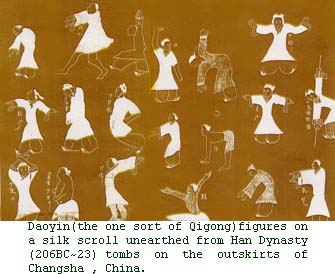Qigong ( |
Xue Yongbin In the late 1970‚“', a new phenomenon appeared in the main cities in China, it attracted the attention of the people. Every morning many people gathered and practiced a kind of physical exercise which was gentle and slow, similar to Taijiquan(Tai Chi Chuan), yet the movement tend to be more repetitive than Taijiquan;usually the feet did not move, the movement did not seem to direct at certain direction; the practitioners looked to be concentrating their minds on things inside their bodies, rather than on their external movement; they seemed to be looking for things and absorbing things,and wanted to be sure of the sensations inside their bodies. |
 |
Most of the practitioners were in their middle age or senior age. Many of them had illness or sickness. One of them might tell you that he was ill, and he had recovered or he felt much better after doing the exercise. Another might tell you that he felt very good and uplifting after doing the exercise, and he was confident that would be able to maintain his health. The exercise is called Qigong, it combines knowledge both physical and psychological, and it has a long history in China. The Beginning of QigongAbout 4000 years ago, people already knew that human beings were a part of the universe, and only with a harmonious relationship with nature can the human being survive and develop. This is a philosophical view point that human being and nature are one. Like there are day and night in a day, four seasons in a year,and conversion and circulation of energy in nature,the human body also becomes a small universe of regularity, and circulation and conversion of life energy,when deeply affected by some factors. People in ancient times believed that if one can keep life energy moving in good regularity and in balance, one would be healthy; otherwise, one would be sick or ill. People in ancient times called life energy Qi, called its passages meridian (or channels and collaterals), and called meeting point of meridian (channels and collaterals)energy points. When one is sick or ill, one is believed to have imbalance in Qi movement. Human body is a part of nature, so one may get what one needs from nature to regain balance. People in ancient times did extensive research into various plants and herbs, they found that part of them might cure diseases, they began to use those as medicine, and they used them according to the condition of person who was sick or ill. This was the beginning of the Traditional Chinese Medicine. With stimulation to certain energy points and regulation of movement of the Qi, it may make the movement of the Qi balanced, and the diseases cured. These are called acupuncture or massage. People in ancient times also found that with proper adjustment to one's posture and breathing based on unity of body and mind, one would feel a sense of openness and fell good, some people even regained health. According to the views of Traditional Chinese Medicine, correct and comfortable posture, concentration of the mind in tranquility, and natural abdominal respiration help in improving the power of the Qi and the movement of the Qi, therefore improving health. This is later called Qigong. |
 |
Like Traditional Chinese Medicine,acupuncture, and massage, Qigong is also in the field of Chinese Medicine, it is used as a way of treatment. At the same time, it also an exercise based on unity of the mind and body, and is used for health preservation. Many people practice it, research it, and apply it. Over the years, many schools have been developed from it. Traditional martial arts absorbed inner adjustment and control of Qigong and developed into Inner Power Martial Arts, in which inner power is used to restrain external power from the other, and the mind is used to sense the weak point of the other and appropriate power is applied to restrain incoming force from the other. Later, on the basis of many schools of inner power martial arts, combining the philosophy of the Yin(negative) and the Yang(positive), and absorbing the essence of Qigong, Taijiquan was created. Qigong has had profound influence not only in the fields of medicine, health, and martial arts, but also in the fields of philosophy, arts, and culture in China. (Translated by Xue Yongxin) |